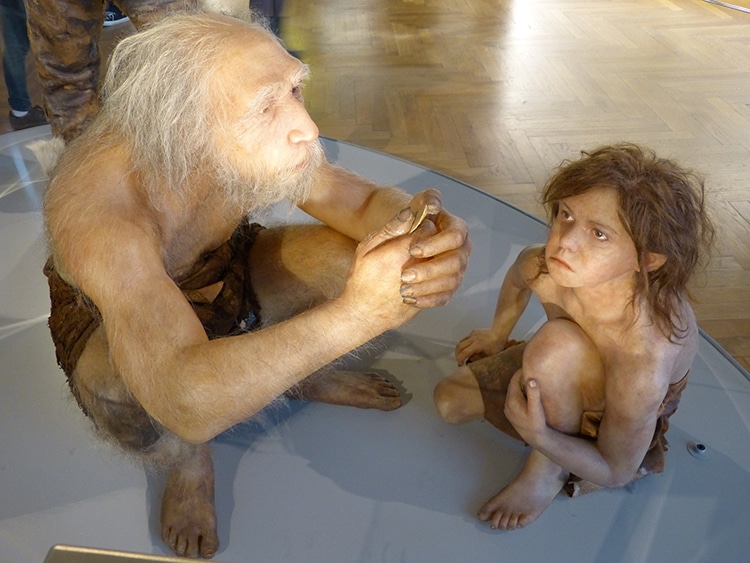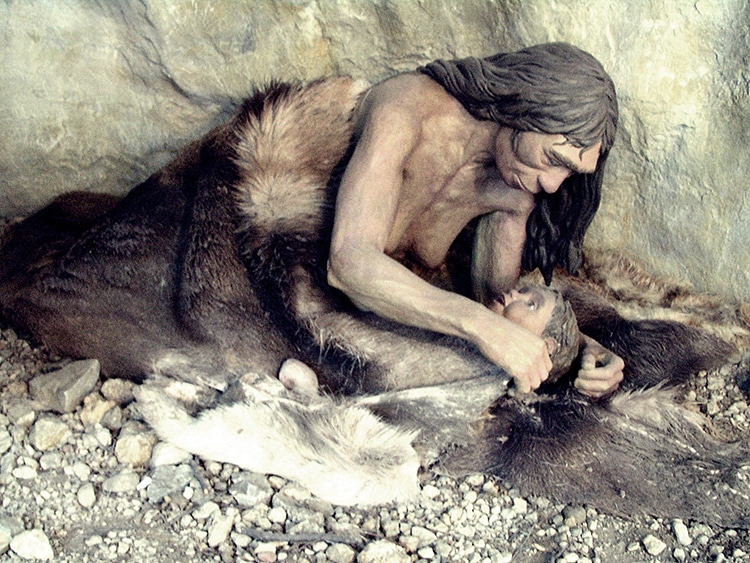
A model of a Neanderthal man and child at the Natural History Museum, Vienna, Austria. (Photo: Wikimedia Commons, CC BY-SA 4.0)
In 1989, excavations at a Paleolithic cave site known as Cova Negra in Valencia, Spain, turned up the remains of a Neanderthal child. The fossilized bones might at first seem little more than evidence of skull formation among these early human relatives; however, examination by scientists has revealed congenital differences in the inner ear that are indicative of Down’s syndrome. A recent paper in Science Advances suggests that the discovery of the remains of a child with Down’s syndrome who lived until the age of 6 indicates altruistic caregiving and the sharing of obligations among prehistoric Neanderthals.
Down’s syndrome results from an extra copy of a chromosome, and today most individuals can live healthy and happy lives with appropriate healthcare and social supports. In prehistoric times, however, researchers have hypothesized that children born with the condition typically did not survive infancy. But the bones of the Neanderthal child from Valencia are not those of an infant.
The researchers estimate the child lived to about 6 to 7 years old. Similarly, they believe the formation of its remains suggest only Down’s syndrome as opposed to other explanations. This child’s age indicates that they survived past infancy with the devoted care of a mother.
Evidence of Neanderthals caring for one another has been documented before, but some doubt has existed among scholars over the extent of true altruism. Did Neanderthals just help those who could reciprocate? This new evidence suggests the caring was not so limited. A young child with a disability would have required care, and perhaps others in the social group had to step up to allow the mother to care for the child.
“Caregiving and collaborative parenting occurred together in Neanderthals,” the authors write, “and [this shows] that both prosocial behaviors were part of a broader social adaptation of high selective value that must have been very similar to that of our species.”
The remains of a prehistoric Neanderthal child with symptoms of Down’s syndrome suggests caring and altruism among the species.

Neanderthal mother and child depicted in a model at a Czech Republic museum. (Photo: Wikimedia Commons, CC0 1.0 Public domain)
h/t: [IFL Science]
Related Articles:
8,000-Year-Old Patagonia Cave Art Illuminates Ancient Climate Change
130,000-Year-Old Carved Bear Bone May Be the Earliest Neanderthal Art
Oldest Neanderthal Engravings Have Been Preserved in a Cave for 57,000 Years
Man Solves 20,000-Year-Old Cave Drawings Mystery That’s Been Stumping Archeologists
